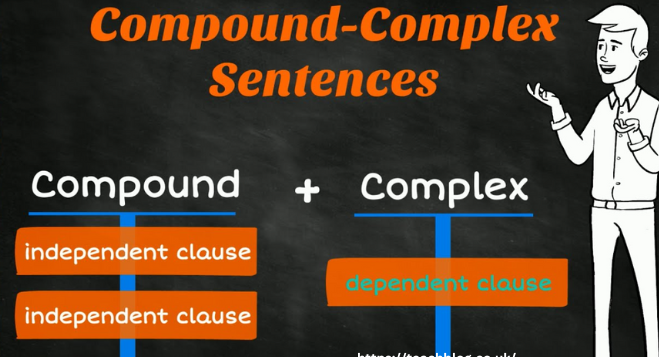Sentences are the building blocks of language, and they come in various forms, each serving its purpose in communication. One of the more intricate sentence structures in the English language is the compound complex sentence. This type of sentence combines the elements of both compound and complex sentences to create a more nuanced and layered structure. In this step-by-step guide, we’ll dive deep into what a compound complex sentence is, how to understand it, and how to identify it with examples.
Table of Contents
What is a Compound Complex Sentence?
A compound complex sentence is a sentence that consists of at least two independent clauses and one or more dependent clauses. It combines the characteristics of both compound sentences (which have two or more independent clauses) and complex sentences (which contain an independent clause and one or more dependent clauses).
Key Components of a Compound Complex Sentence:
- Independent Clause: A group of words that can stand alone as a sentence because it expresses a complete thought. Example: “She went to the store.”
- Dependent Clause (or Subordinate Clause): A group of words that cannot stand alone as a sentence. It provides additional information but depends on the independent clause to form a complete thought. Example: “Although she was tired.”
- Coordinating Conjunctions: These connect independent clauses. Common ones include and, but, or, so, nor, for, yet.
- Subordinating Conjunctions: These introduce dependent clauses, such as because, although, since, when, if.
Formula for a Compound Complex Sentence:
Independent Clause + Coordinating Conjunction + Independent Clause + Subordinating Conjunction + Dependent Clause
For example: “I went to the store, and I bought some apples because they were on sale.”
Here, “I went to the store” and “I bought some apples” are independent clauses, while “because they were on sale” is the dependent clause.
Understanding Compound Complex Sentences
To fully grasp the concept of a compound complex sentence, it helps to break down its parts. Let’s begin by understanding the components that come together to form this type of sentence.
Independent Clauses
An independent clause is like a stand-alone sentence. It has a subject and a verb and expresses a complete thought. In a compound complex sentence, you will find at least two independent clauses.
Example:
- “The sun was shining.” (Independent clause)
- “We decided to go for a walk.” (Independent clause)
When these two independent clauses are joined together by a coordinating conjunction, they form a compound sentence.
Compound Sentence Example:
- “The sun was shining, and we decided to go for a walk.”
Dependent Clauses
A dependent clause does not form a complete sentence on its own. It adds extra information to the independent clause but needs the independent clause to make sense.
Example:
- “Although it was cold outside.” (Dependent clause)
In a complex sentence, the dependent clause adds more depth to the independent clause.
Complex Sentence Example:
- “Although it was cold outside, the sun was shining.”
How They Come Together in a Compound Complex Sentence
In a compound complex sentence, you have both independent clauses and dependent clauses coming together to form a more detailed sentence. The independent clauses are joined by a coordinating conjunction, while the dependent clause is connected to one of the independent clauses by a subordinating conjunction.
Compound Complex Sentence Example:
- “Although it was cold outside, the sun was shining, and we decided to go for a walk.”
In this sentence, “the sun was shining” and “we decided to go for a walk” are the independent clauses, while “Although it was cold outside” is the dependent clause.
Examples of Compound Complex Sentences
- “Because the weather was nice, we went to the beach, and we had a picnic.”
- Independent Clauses: “We went to the beach” and “we had a picnic.”
- Dependent Clause: “Because the weather was nice.”
- “I wanted to go to the concert, but I couldn’t because I had to work.”
- Independent Clauses: “I wanted to go to the concert” and “I couldn’t.”
- Dependent Clause: “Because I had to work.”
- “The dog barked loudly, and the neighbors complained because they were trying to sleep.”
- Independent Clauses: “The dog barked loudly” and “the neighbors complained.”
- Dependent Clause: “Because they were trying to sleep.”
- “Although he was tired, John finished his homework, and he went to bed early.”
- Independent Clauses: “John finished his homework” and “he went to bed early.”
- Dependent Clause: “Although he was tired.”
In these examples, you can see how the compound complex sentence structure allows for more detailed and sophisticated communication.
How to Identify a Compound Complex Sentence
Identifying a compound complex sentence is easier when you break it down into its parts.
- Look for the Independent Clauses: Start by identifying the independent clauses in the sentence. These clauses should be able to stand alone as complete sentences.
- Check for Dependent Clauses: Next, find the dependent clause(s). These will usually begin with subordinating conjunctions like “although,” “because,” “since,” “when,” etc.
- Spot the Coordinating Conjunctions: Look for coordinating conjunctions (and, but, so, for, or, yet, nor) that link the independent clauses.
- Ensure Both Clause Types Are Present: For the sentence to be compound-complex, it must have at least two independent clauses and one or more dependent clauses.
Example Analysis
Consider the sentence:
- “Even though it was raining, we went to the park, and we had a great time.”
- Independent Clauses: “We went to the park” and “we had a great time.”
- Dependent Clause: “Even though it was raining.”
- Coordinating Conjunction: “and.”
- Subordinating Conjunction: “Even though.”
This sentence is a compound complex sentence because it has two independent clauses, one dependent clause, a coordinating conjunction, and a subordinating conjunction.
Conclusion
A compound complex sentence is a powerful tool in writing, allowing for the expression of multiple ideas with clarity and depth. By combining two or more independent clauses with one or more dependent clauses, you can create rich, nuanced sentences that convey complex relationships and ideas. Understanding how to recognize and use compound-complex sentences will not only improve your writing but also enhance your ability to communicate effectively in both formal and informal settings.



















